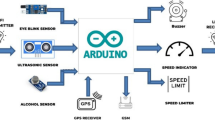Abstract
In the actual vehicular communications development, GeoNetworking is one of the key aspects to support efficient and coherent wireless information transmission among vehicles that circulates in a common road infrastructure, feeding of information safety cooperative systems. However, the efforts are focused mainly in the development of the communication technology, standardization and harmonization, leaving GeoNetworking and other intermediate systems for a future development. Even GeoNetworking is considered a key element in the vehicular communications architecture; very few operative results are available today and is a still open research field. In this paper we present an implementation of GeoNetworking algoritm, designed to support efficient, robust and reliable vehicular communications, using the wireless Sensor Network communications technology but extendable and compatible with IEEE 802.11p. The algorithms have been tested in simulations and real situations, supporting data transmission in highway driving situations.
Resumen
En la actualidad, se está llevando a cabo una intensa labor con el fin de investigar y desarrollar sistemas de comunicaciones vehiculares, que servirán de soporte a los denominados sistemas de seguridad cooperativos. Varias normas, prototipos y pruebas operativas sobre el terreno están en proceso de desarrollo en todo el mundo, implicando tanto a centros de investigación como a fabricantes de vehículos y de electrónica. Sin embargo, algunas líneas de investigación aún están abiertas hoy en día, fundamentalmente en el ámbito de garantizar comunicaciones vehiculares con la suficiente calidad en cuanto a fiabilidad y robustez para dar ser vicio a aplicaciones de asistencia y seguridad en la conducción. Uno de estos retos es el desarrollo de soporte de comunicaciones basadas en topología física de los nodos o GeoNetworking. Este concepto significa que la red ad-hoc vehicular (VANET) basa la transmisión de los paquetes de datos en la localización topográfica de los diferentes nodos (vehículos) de la red, organizando el flujo de datos de una manera óptima que cubra los alrededores de cada vehículo. El núcleo de este sistema GeoNetworking es el algoritmo GeoRouting, que soporta el encaminamiento óptimo de los paquetes de datos y reorganiza la estructura de la red en función de las posiciones de los nodos. En esta ponencia se presenta un nuevo algoritmo GeoRouting, basado en la evolución de los resultados anteriores de redes vehiculares malla. Este algoritmo se ha diseñado, implementado y probado en vehículos reales en carreteras reales con flujo de tráfico libre. Los resultados sugieren que las características del algoritmo de enrutamiento diseñado se pueden aplicar como núcleo de cualquier tipo de red vehicular para soportar aplicaciones de asistencia a la conducción basadas en sistemas de seguridad cooperativos.




Similar content being viewed by others
Referencias
Jiménez, F., Naranjo, J. E., García, F., & Armingol, J. M. (2011). Can low-cost road vehicles positioning systems fulfil accuracy specifications of new adas applications. The Journal Of Navigation, 64, 251–264.
JE Naranjo, JG. Zato, L. Redondo, M. Oliva, F. Jiménez and N. Gómez. (2011) Evaluation of V2 V and V2I Mesh Prototypes based on a Wireless Sensor Network. 14th International IEEE Conference on Intelligent Transportation Systems, Washington, DC, USA. October 5–7, 2011.
A. Buchenscheit, F. Schaub, F. Kargl, M. Weber. (2009) A VANET-based emergency vehicle warning system, IEEE Vehicular Networking Conference (VNC).
Le, L., Festag, A., Baldessari, R., and Zhang, W. (2009) Vehicular wireless short-range communication for improving intersection safety, IEEE Communications Magazine, November.
F. Jiménez, J.E. Naranjo, F. García, F. Aparício, J.G. Zato, J.M. Armingol (2009) A. de la Escalera “Analysis of inertial measurement systems limitations for vehicle positioning in new adas applications” 16th ITS WORLD CONGRESS STOCKHOLM. Septiembre 2009.
ISO 21217 (2010). Intelligent Transport Systems -- Communications access for land mobiles (CALM) – Architecture.
Choi, J.H., Khaled, Y., Tsukada, M., and Ernst, T. (2008). IPv6 support for VANET with geographical routing, in 8th International Conference on Intelligent Transport System Telecommunications (ITST’08), Phuket, Thaïland.
Gordillo, A., Calderón, M., and Bernardos, C.J. (2009) Enabling IP geomulticast services for vehicular networks, ITST’09, Lille, France.
ETSI EN 302665 (2010) Intelligent Transport Systems (ITS); Communications Architecture, European Standard (Telecommunications series), Europ. Telecomm. Standards Inst.
ETSI TS 102636–4-1 V1.1.1 (2011–06). Technical Specification. (ITS); Vehicular communications; GeoNetworking; Part 4: Geographical addressing and forwarding for point-to-point and point-to-multipoint communications; Sub-part 1: Media-Independent Functionality, Europ. Standard, Europ. Telecomm. Standards Inst., 2011.
Matolak, D.W., Sen, I., Xiong, W. (2006). Channel Modeling for V2 V Communications, Mobile and Ubiquitous Systems Workshop 2006, 3rd Annual Int. Conference.
TinyOS TEP 119 (2005). http://www.tinyos.net/tinyos-2.x/doc/html/tep119.html.
Agradecimientos
Este trabajo ha sido realizado gracias al apoyo del Ministerio de Economía y Competitividad (TRA2010–0225-C03–03 y TRA2010–15645) y a la Red de Excelencia de la Comunidad de Madrid SEGVAUTO-II.
Author information
Authors and Affiliations
Corresponding author
Rights and permissions
About this article
Cite this article
Anaya, J.J., Talavera, E., Naranjo, J.E. et al. Vehicular GeoNetworking based communications to support cooperative safety systems. Securitas Vialis 9, 69–75 (2017). https://doi.org/10.1007/s12615-016-9096-8
Published:
Issue Date:
DOI: https://doi.org/10.1007/s12615-016-9096-8




